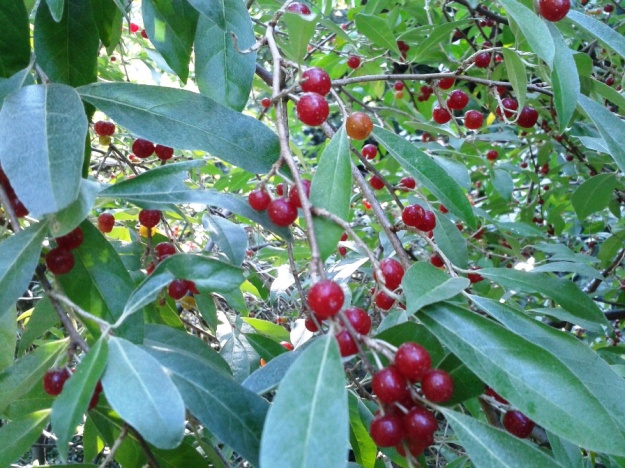There’s not really much going on flower wise in the garden right now except for the sedum which are having one of the best years ever. But the shrubs, trees and vines are doing their thing and producing berries and fruit like crazy…which will serve as bird food in the coming months.
The pokeweed pictured below is ready to eat and the catbird guards it when he isn’t devouring the berries. I’ve got this 1936 book, “Taylor’s Encyclopedia of Gardening”, and they say that the root, that resembles horseradish in appearance, is extremely poisonous – even deadly – yet the foliage is used by some for spring greens! Hmmm…don’t think I’ll be trying that next spring.
Actually, I have monkshood that should be blooming in a couple of weeks and that, too, is extremely poisonous. Did Agatha Christie write a murder mystery about a botanist that was killing people by using poisonous plants? If she didn’t, she should have. Belladonna, delphinium, floxglove, oleander, rhododendron, castor plant, deadly nightshade and yew are a few of the poisonous plants. And let’s not forget some of those mushroom varieties!
The dogwood berries are plump and red and should be ready to eat soon. Cardinals love these berries and so do the squirrels. They start at the top of the tree and work their way down until there is not a berry in sight.
The fruit of the autumn olive, pictured below, is also almost ready to be consumed by a variety of birds. However, their droppings propagate seedlings and before you know it, you have a sea of little autumn olive trees sprouting up in your yard. You have to keep on top of these or otherwise they will take over your yard! Believe me, I know.
It’s really weird…the huge holly tree that is usually covered with berries doesn’t seem to have any berries on it this year. The tree by the barn, however, has a good amount of them. They’re still green, of course, and won’t be eaten by the birds until probably January or February.
The euonymus are loaded with fruit….
as are the pyracantha (fire-thorn)…
and the bittersweet. Ah, the bittersweet. The fruit is just starting to turn to yellow from green and will be a beautiful orange color when ripe at which time it will burst open and show a bright yellow interior. It is gorgeous in wreaths and floral arrangements. But it is an invasive vine that pops up all over the place (the doing of those birds again). Try to control it…hah! That is what I will try to do today (nice day to work outside…low 70’s and gorgeous). Actually, there is no way I can control bittersweet. All I can do is remove it from winding its way up trees and shrubs and cut it down to the ground if I can’t pull it out by the roots. And even if you do pull it out by the roots, there is always a little bit of the root left in the ground which will spring back up and again try to choke the life out of all the plants around it.
And now, moving along to the mysterious missing beans that I discussed earlier this year, maybe I’ve solved the case. I was sitting at the computer and out of the corner of my eye I saw some movement on the bean pole. Looking carefully at the pole, I could see a tiny little frog that was just about the same gray color as the pole. I grabbed the camera and ran outside and he was good enough to let me take a few shots.
I did a little research on the gray treefrog and for the most part they eat insects. But could it be this one thought those tiny little fuzzy beans were insects? Don’t know for sure, but right now he is on my short list of suspects.








